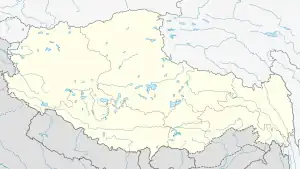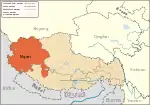Jaggang
Chakgang,[1][2][lower-alpha 1] or Jaggang[6] (Tibetan: ལྕགས་སྒང, Wylie: lcags sgang;[7][8] Chinese: 甲岗; pinyin: Jiǎ gǎng, often transliterated Jiagang),[9][10] is a village in the Rutog County, Ngari Prefecture in the Tibet region of China.[4] It is on a wide plain at a major junction in the Maga Zangbo valley where several tributary streams join the river. It is traditionally known for its barley cultivation.[4] The area was used as a base for Chinese military operations in the Demchok sector in the 1962 Sino-Indian War.[10]
Chakgang/Jaggang
甲岗村 | |
|---|---|
Village | |
| Jiagang Cun | |
 Chakgang/Jaggang | |
| Coordinates: 32.882°N 79.792°E | |
| Country | China |
| Region | Tibet |
| Prefecture | Ngari Prefecture |
| County | Rutog County |
| Township | Risong Township |
| Elevation | 4,523 m (14,842 ft) |
| Population (2018) | |
| • Total | 700+ |
| • Major Nationalities | Tibetan |
| • Regional dialect | Tibetan language |
| Jaggang | |||||||
|---|---|---|---|---|---|---|---|
| Chinese | 甲岗村 | ||||||
| Hanyu Pinyin | jiǎ gǎng cūn | ||||||
| Literal meaning | Jiagang Village | ||||||
| |||||||
Jiagang Cun (Chinese: 甲岗村; pinyin: Jiǎ gǎng cūn), i.e., "Jaggang Village", includes a wider area in the Maga Zangbo valley with numerous settlements. Between 2014 and 2018, a model village was constructed at the former campsite called Jibajiawu, upstream on Maga Zangbo 15 km west of Chakgang, which was also described as being part of Jiagang Cun. The development received significant publicity.[11][12][13][14] Jiagang Cun is said to have a high proportion of communist party members (106 out of a population of 1000).[15] The 11th Panchen Lama visited the village in July 2019 to examine the living conditions afforded by the new development of the area.[16]
Geography
The location of Chakgang is often marked on maps and atlases as being half-way between Rutog and Shiquanhe.[1][17][18] The location is virtually identical with that of Churkang in older maps.[19] The location is on a wide plain in the Maga Zangbo valley where a number of routes arrive, from Ladakh via Chang La, from Demchok via Jara La, and from Tashigang and Shiquanhe via Kalinka La. A monthly fair used to be held at this location, visited by traders from Ladakh and Lahul, who would exchange the produce of India for pashm, wool, salt and other products.[5][20]
The Maga Zangbo (or Tsangpo) river is formed from the streams on the southern slopes of the mountains south of Rutog. It flows in a wide arc, eventually trending north and draining into the Pangong Lake at its eastern end. Churkang and Chakgang are at the location where the river starts flowing north, and several streams from the south and east join it. The land is fertile and barley has been traditionally cultivated in the area.[4]
At present, under Chinese administration, a village has been incorporated under the name "Jiagang Cun", which appears to include several settlements other than Chakgang. At a location called Jibajiawu (or Gie Bajiawu), 15 km west of Chakgang, a model village has been constructed between 2014 and 2018, which is described as part of Jiagang Cun.[11][12][13][14] In the valley to the east of Chakgang, two further villages at Womai Xiong and Queding are also marked as belonging to the Jiagang Cun area.[2][21] Another settlement called Chiakang (Chinese: 且砍; pinyin: Qiě kǎn) further upstream on Maga Zangbo may also be part of Jiagang Cun.
Sino-Indian border dispute
The Maga Zangbo river valley and Jaggang are adjacent to the Demchok sector disputed between India and China. India claims a border running along the Chang La and Jara La passes whereas China claims a border running west of the Indus Valley. In addition, the Xinjiang–Tibet Road (currently G219) that runs through Indian-claimed Aksai Chin region also runs through Jaggang. For all these reasons, Jaggang is considered a key border village of Chinese-controlled Tibet and it is frequently presented as such in official media.[22]
The village is located about 80 kilometers from the county seat of Rutog Town, and 80 kilometres northeast of the Dumchele border trading point in the Skakjung valley (Indus valley).[14]
A 40 km-long 'class 9 fair weather road' from Churkang to Chang La was built prior to the 1962 Sino-Indian War.[23] The road has now been extended to Dumchele.
Demographics
In 2016, there were 691 people in 185 households in Jaggang village.[12] This increased to 197 households with 723 people in 2018.[11] The per capita income in 2016 was CN¥ 8,060 yuan (US$1228.10).[12]
In 2019 the village had 106 Chinese Communist Party members.[24]
Economy
The village has a collective economy focusing on manufacturing, border trade, development of nurseries and husbandry. The residents are provided with government subsidies for living in the border regions. The village has access to water, electricity and cellular network coverage.[6]
See also
References
- Dorje, Gyurme (2004), Footprint Tibet (3rd ed.), Footprint Books, p. 394, ISBN 1-903471-30-3 – via archive.org: "[The road from Senge Khabab or Shiquanhe] crosses La-me La pass after 31 km, leaving the Indus basin to descend into the valley of the Maga Zangbo. The township of Chakgang is 26 km below the pass, and from there to Risum [Risong] township it is a further 30 km."
- Chakgang, Rutog County, kmaps.virginia.edu, retrieved 12 June 2021.
- Arpi, Claude (2019-08-19), "The Chinese Panchen Lama on the Indian Border", Indian Defence Review
- Hedin, Sven (1922), Southern Tibet: Discoveries in Former Times Compared with My Own Researches in 1906–1908: Vol. IV – Kara-korum and Chang-Tang, Stockholm: Lithographic Institute of the General Staff of the Swedish Army, p. 195
- Report on the External Land Trade of the Punjab, Punjab (India). Land Records Department, 1906, p. 1
- "Jaggang Village model unit in China's Tibet poverty relief campaign". Xinhua English News. 2018-09-18.
- Extracts from the Place name database: Ngari Prefecture, Estonian Language Institute (KNAB), retrieved 2021-06-12.
- Guansheng, Chen; Caidan, An, eds. (2004), Dictionary of Common Tibetan Personal and Place Names, Beijing: Foreign Languages Press, p. 142, ISBN 7-119-03497-9 – via archive.org
- "Xīzàng jūnmín yúshuǐqíng mínzú tuánjié gù guófáng" 西藏军民鱼水情 民族团结固国防 [Tibetan military, civilian, fish, water regime, national unity and national defense], China Tibet Net, 2021-04-26
- Sandhu, Shankar & Dwivedi, 1962 from the Other Side of the Hill (2015), p. 52.
- "Xīzàng ālǐ: Jiànshè zhōng de biānjìng xiǎokāng shìfàn cūn-xīnhuá wǎng" 西藏阿里:建设中的边境小康示范村-新华网 [Ali, Tibet: a well-off demonstration village on the border under construction]. Xinhua News Agency. 2018-09-18.
- "Ālǐ jiǎ gǎng cūn: Gǔ qǐ mèngxiǎng de fēngfān_zīxùn_zhōngguó xī cáng wǎng" 阿里甲岗村:鼓起梦想的风帆_资讯_中国西藏网 [Ali Jiagang Village: Mustering the Sail of Dreams]. China Tibet Net. 2018-01-17.
- "རུ་ཐོག་རྫོང་རི་གསུམ་ཤང་ལྕགས་སྒང་གྲོང་ཚོའི་རྣམ་པ་གསར་པ།" (in Tibetan). China Tibet Net (Tibetan). 2017-10-15.
- "Ālǐ dìqū biānjìng xiǎokāng cūn jiànshè gōngzuò zòngshù:"Hǎo zhèngcè ràng rìzi yuèguò yuèměi"" 阿里地区边境小康村建设工作综述:"好政策让日子越过越美"_岗村 [Summary of the construction of a well-off village in the border area of Ngari: "Good policies make life more beautiful"]. www.sohu.com. 2020-11-09. Retrieved 2020-11-21.
- "[Biānjiāng dǎngqí hóng] xīzàng bān gōng húpàn jīcéng dǎngyuán tán shǐmìng" 【边疆党旗红】西藏班公湖畔基层党员谈使命 [[Frontier Party Flag Red] Grassroots Party members on the bank of Bangong Lake in Tibet talk about their mission], China Tibet Net, 2019-09-02
- ""Xīn tiēxīn de jiāoliú" shíyī shì bānchán zài nóng mù mínjiā zhōng huà jiācháng" “心贴心的交流” 十一世班禅在农牧民家中话家常 ["Intimate communication" The 11th Panchen Lama talked about everyday life in the homes of farmers and herdsmen], China Tibet Net, 2019-08-03
- Lonely Planet: Tibet (8th ed.), Lonely Planet, 2011, p. 164, ISBN 978-1741792188 – via archive.org
- Collins Concise Atlas of the World, William Collins Sons & Co., 1984, p. 41 – via archive.org
- Constable's Hand Atlas of India, Archibald Constable & Company, 1893, Plate 25 – via archive.org
- Montgomerie, T. G. (1870), "Narrative Report of the Trans-Himalayan Explorations during 1868", Journal of the Asiatic Society of Bengal, 36 (part 2, issue 1): 48
- Tianditu mapping website, search key Chinese: 沃賣雄; pinyin: Wò mài xióng. Retrieved 20 June 2021.
- Gèngǔ huāngyuán biànle yàng——ālǐ dìqū rì tǔ xiàn rì sōng xiāng jiǎ gǎng cūn lüèyǐng 亘古荒原变了样——阿里地区日土县日松乡甲岗村掠影 [Jiagang Village, Ritu County, develops "the first village of border construction"], Government of Ngari Prefecture, al.gov.cn, 2019-05-31: "Only when border residents live and work in peace can the border be stable. Following this line of thinking, in 2014, the Ritu County Party Committee and the County Government coordinated... funds... and ... the construction of a well-off village on the border of Jiagang was launched."
- Malhotra, A. (2003). Trishul: Ladakh And Kargil 1947-1993. Lancer Publishers. pp. 43, 45. ISBN 978-81-7062-296-3.
- "[Biānjiāng dǎngqí hóng] bān gōng húpàn jīcéng dǎngyuán tán shǐmìng" (边疆党旗红) 班公湖畔 基层党员谈使命 [[Border Party Flag Red] By the bank of Bangong Lake, grassroots party members talk about their mission]. CCTV. 2019-09-01 – via m.yicai.com.
Bibliography
- Sandhu, P. J. S.; Shankar, Vinay; Dwivedi, G. G. (2015), 1962: A View from the Other Side of the Hill, Vij Books India Pvt Ltd, ISBN 978-93-84464-37-0
External links
- "[Walking in the Clouds] Jiagang Village, Tibet: Green Hope on the Golden Land (photo feature)". China Tibet Net News, media.tibet.cn. Retrieved 2021-06-12. — Pictures of Chakgang village development
